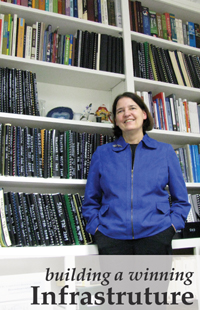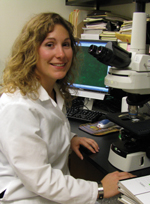|
|
|

|
Researchers beat national average in landing grants
|
by Dawn Brazell
Public Relations
Sometimes great things do come in small packages.
Just take MUSC’s College of Graduate Studies with its 284 students.
Though it’s small in numbers, its Ph.D. students hold the bragging
rights to an 80 percent success rate in receiving the prestigious
National Institutes of Health (NIH) National Research Service Awards
(NRSA), compared to the national average of 30 percent. Currently, 22
students hold the awards. For a list of award recipients, visit
http://www.musc.edu/catalyst/archive/2011/co1-28winners.html.
 Some of the award
recipients in the College of Graduate Studies. Some of the award
recipients in the College of Graduate Studies.
Perry V. Halushka, M.D., Ph.D., dean of the College of Graduate
Studies, said the college has held this rate for several years. The
Ruth Kirschstein National Research Service Award is the most
competitive fellowship that a graduate student or a M.D./Ph.D. student
can receive.
“When I tell my colleagues about the success of our program, it just
blows them away. We have a terrific graduate program now. There’s a gem
here that many people don’t know about.”
The three components of the training grants are based on the quality of
the students, mentors and the research. Halushka credits the high
success rate to the quality of the training plan between the mentor and
student that turns trainees into the independent scientists that they
need to become.
“To me the whole Ph.D. experience is learning how to ask and answer
important scientific questions. You learn techniques, you learn
technology, but it’s all to answer questions. It’s all about learning
to problem-solve. That’s how people become successful as scientists.”
Science is fast-paced, which is even more the case as technology
advances, he said. “What you learn today as a Ph.D. student
technique-wise, five or six years from now, you may never use again.
That’s what you expect. It’s the training that’s important. I want our
trainees to learn how to take risks and think outside of the box.”
The right stuff
That depends on getting the right people, of course. The goal of
Cynthia F. Wright, Ph.D., associate dean for admissions and career
development, is to recruit and retain high-caliber students, the kind
of students who can land training grants.
“These training grants are important because they demonstrate that our
programs have been evaluated by funding agencies, largely NIH, and
found to be worthy of receiving funding support,” said Wright. “This
means that our training program, faculty, and student quality are
competitive with the best programs in the nation.
“We are small enough to have close interaction between trainees and
faculty and yet large enough to provide world-class facilities to our
students and researchers,” she said. “There is a feeling of growth and
excitement here that we are always getting better, and we are
attracting great faculty and students.”
They also pay attention to the nuts and bolts involved, such as the
summer grant training class taught by Ed L. Krug, Ph.D., assistant dean
for postdoctoral affairs. The course prepares students to write grant
applications.
 Dr. Joann Sullivan
keeps winning research grant applications on hand. Dr. Joann Sullivan
keeps winning research grant applications on hand.
Joann F. Sullivan, Ph.D., director of the office for research
development, praises how the course helps students stay ahead of the
competition.
“The bar with NRSA is always being raised. We always have to be one
step ahead of the curve.”
Her office’s relationship with the college has been a factor in the
success of getting repeating renewals on training grants, she said.
They keep past successful applications and reviewers’ critiques and
comments to serve as a training guide. They also provide an
institutional boiler plate of applications, maintain several
databases needed for individual and institutional grants, track
competing grants and provide general assistance. She tries to make sure
the institutional infrastructure is in place to support the students
because they all know what the expectation is, she said. Students are
expected to land these training grants.
“I think it’s Dean Halushka’s can-do attitude,” she said of a critical
factor behind the college’s success rate. “He’s so supportive of these
applications. He’s a problem solver. He’s responsive to what we need.”
Mentor magic
 Linnea Freeman
works in her lab. Linnea Freeman
works in her lab.
Graduate student Linnea Freeman said the grants focus on the training
experience a student gets, and she has been impressed by the feedback
she’s gotten from her mentors and collaborators.
“We have great preparation from our grant writing course in the summer.
We also have great examples from people at the university who write
grants all the time. NIH is looking for grants that have clinical
relevance. Because we’re at the medical university, we’re doing basic
science research at the bench that has a lot of clinical relevance, and
we can bridge that to what’s being done at the hospital. I think we can
have the relevance that NIH is looking for to get those grants.”
Speaking from her experiences of working with the Department of
Neurosciences, Freeman said she’s had access and exposure to the latest
techniques and high-tech equipment. One of her colleagues, for example,
is using laser light that can control how the brain works by turning on
or off specific proteins or actions within the brain.
“Everyone here is hands-on with the best equipment. That kind of
technology isn’t being used at many other research universities.”
She also likes how small the graduate classes are, which allows her to
have more one-on-one time with mentors and other professors.
“I feel like there is always more than one person available to talk
to—there’s a lot of collaboration here. For example, if there’s a
technique that your lab doesn’t have experience with, there’s always
someone you can go to who is happy to help you. That brings that
technique into the lab, so that lab only gets stronger.”
Krug said he’s found the most important characteristic of a good
training environment is the belief of the faculty and administration
that its students and post-doctoral scholars are capable of great
achievement, and then providing the support to make it happen. It’s a
team effort that gets the job done, he said, listing some of the
influential staff.
- Sullivan gives an overview of the National
Institutes of Health extramural funding programs, replete with valuable
tips on the fellowship application itself.
- Tom Smith, Ph.D., associate director of the
Center for Academic Excellence, discusses the importance of rhetoric
conducive to effective communication with reviewers.
- Sharon Yeatts, Ph.D., assistant professor of
biostatistics, helps students focus on the critical elements of
experimental design.
- Robbie Lee and Amy Boehm of the Office of
Research and Sponsored Programs, conduct a step-by-step hands-on
workshop for submitting the final fellowship application to NIH via the
Cayuse portal.
“But perhaps one of the most influential components of the course is
the involvement of many postdoctoral scholars who serve as facilitators
of small study section group discussions where the students critique
each other’s proposal drafts. My role is to simply bring all these
players together and stay out of the way.”
Krug said one of the joys of his job is to watch how the mentoring and
collaborative process shapes the professional development of students.
Professional development without mentoring is a hit-or-miss process.
Students and postdoctoral scholars benefit tremendously from faculty
sharing lessons learned and listening to their individual aspirations
and goals. They provide constructive feedback on students’ strengths
and weaknesses that might impact achieving those goals.
The preparation of a fellowship application is the perfect platform to
facilitate such mentoring interactions, he said. Describing the
transition from undergraduate to graduate student as a “titanic
moment,” Krug said students move beyond textbook learning to a process
that creates new knowledge. Postdoctoral trainees also face significant
issues, especially when entering an increasingly competitive job
market.
“One needs a good number of life boats on board to persevere through
the challenges that are inherent in the process of arriving at a
successful dissertation defense.”
Friday, Jan. 28,
2011
|
|
|





